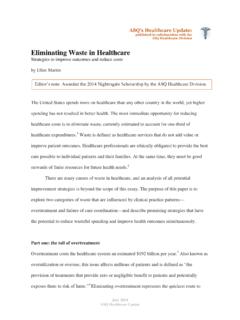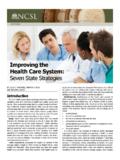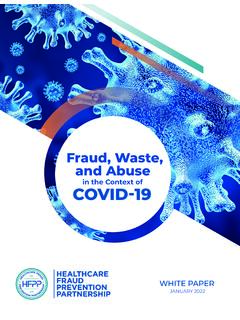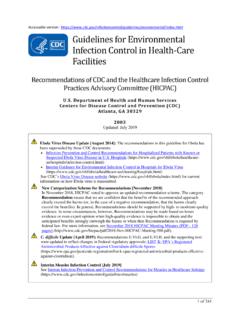Transcription of WATER, SANITATION, AND HYGIENE IN HEALTH CARE …
1 WATER, SANITATION, AND HYGIENE IN HEALTH care FACILITIESPRACTICAL STEPS TO ACHIEVE UNIVERSAL ACCESS TO QUALITY CAREWATER, SANITATION, AND HYGIENE IN HEALTH care FACILITIESPRACTICAL STEPS TO ACHIEVE UNIVERSAL ACCESS TO QUALITY CAREW ater, sanitation and HYGIENE in HEALTH care facilities: practical steps to achieve universal access ISBN 978-92-4-151551-1 World HEALTH Organization 2019 Some rights reserved. This work is available under the Creative Commons Attribution-NonCommercial-ShareAlike IGO licence (CC BY-NC-SA IGO; ).Under the terms of this licence, you may copy, redistribute and adapt the work for non-commercial purposes, provided the work is appropriately cited, as indicated below.
2 In any use of this work, there should be no suggestion that WHO endorses any specific organi-zation, products or services. The use of the WHO logo is not permitted. If you adapt the work, then you must license your work under the same or equivalent Creative Commons licence. If you create a translation of this work, you should add the following disclaimer along with the suggested citation: This translation was not created by the World HEALTH Organization (WHO). WHO is not responsible for the content or accuracy of this translation. The original English edition shall be the binding and authentic edition.
3 Any mediation relating to disputes arising under the licence shall be conducted in accordance with the mediation rules of the World Intellectual Property citation. Water, sanitation and HYGIENE in HEALTH care facilities: practical steps to achieve universal access. Geneva: World HEALTH Organization; 2019. Licence: CC BY-NC-SA IGO. Cataloguing-in-Publication (CIP) data. CIP data are available at , rights and licensing. To purchase WHO publications, see To submit requests for commercial use and queries on rights and licensing, see materials. If you wish to reuse material from this work that is attributed to a third party, such as tables, figures or images, it is your responsibility to determine whether permission is needed for that reuse and to obtain permission from the copyright holder.
4 The risk of claims resulting from infringement of any third-party-owned component in the work rests solely with the disclaimers. The designations employed and the presentation of the material in this publication do not imply the expression of any opinion whatsoever on the part of WHO concerning the legal status of any country, territory, city or area or of its authorities, or concerning the delimitation of its frontiers or boundaries. Dotted and dashed lines on maps represent approximate border lines for which there may not yet be full mention of specific companies or of certain manufacturers products does not imply that they are endorsed or recommended by WHO in preference to others of a similar nature that are not mentioned.
5 Errors and omissions excepted, the names of proprietary products are distinguished by initial capital reasonable precautions have been taken by WHO to verify the information contained in this publication. However, the published material is being distributed without warranty of any kind, either expressed or implied. The responsibility for the interpretation and use of the material lies with the reader. In no event shall WHO be liable for damages arising from its , layout and production by Phoenix Design Aid A/S, Denmark. Printed in STEPS TO ACHIEVE UNIVERSAL ACCESS TO QUALITY CAREC ontentsForeword.
6 VAbbreviations and acronyms ..viExecutive Summary ..viiSection 1 . Background ..1 Why WASH services are a priority in HEALTH care facilities ..1 Barriers to providing WASH in HEALTH care facilities ..2 Section 2 . Commitments and Leadership ..4 Section 3 . Eight Practical Steps to Improve and Sustain WASH in HEALTH care Facilities ..8 1. Conduct situation analysis and assessment ..10 2. Set targets and define roadmap ..13 3. Establish national standards and accountability mechanisms ..15 4. Improve and maintain infrastructure ..18 5. Monitor and review data ..23 6. Develop HEALTH workforce.
7 25 7. Engage communities ..28 8. Conduct operational research and share learning ..31 Section 4 . Addressing the Global Call to Action ..34 References ..37 Annex 1 . Key Definitions ..41 Annex 2: Key Achievements Since 2015 ..43 Annex 3 . WASH FIT: An Overview ..46 Annex 4 . WASH in HEALTH care Facility Tools and their Application ..48 Additional Resources ..52 Acknowledgements ..55 CONTENTSivWATER, SANITATION, AND HYGIENE IN HEALTH care FACILITIESB oxes1. Eight practical steps to improve WASH in HEALTH care facilities2. The association between hand HYGIENE and infection3. Summary of evidence and research needs4.
8 Safe HEALTH care waste management: from neglected issue to an opportunity to benefit human and environmental health5. Ministries of HEALTH commit to greater leadership, investments, and tracking through the proposed 2019 World HEALTH Assembly Resolution on WASH in HEALTH care facilities6. Low-cost WASH interventions rapidly reduce the spread of HEALTH care -associated infections 7. Innovative and environmentally-friendly approaches for WASH improvement 8. Alcohol-based hand rub is a lifesaving technology, but not a substitute for safe, reliable water 9. Approaches to engage communities in designing, implementing and sustaining better services 10.
9 Global WHO/UNICEF knowledge portal for WASH in HEALTH care facilities 11. WASH and HEALTH security 12. The Protocol on Water and HEALTH Case Studies1. How Ethiopia achieved cleaner HEALTH facilities through multi-level leadership2. How Cambodia used a situation analysis to embed WASH into HEALTH system and quality improvement plans3. How Lebanon used a national census to prioritise and inform WASH improvements for primary HEALTH care centers4. How Ghana s national standards for WASH in HEALTH care facilities improved quality of care5. How Liberia is using mentoring and supportive supervision to support implementation of new WASH standards6.
10 How Tajikistan is using WASH FIT to help set targets and update national standards 7. How Sierra Leone is making incremental improvements in treating HEALTH care waste 8. How Nepal used bio-digesters to treat infectious organic 9. How Madagascar is using friendly competition to increase access to WASH in primary HEALTH care centers 10. How Uganda embedded WASH in HEALTH care facility indicators into regular HEALTH monitoring 11. How Lao PDR is using national data to spark action 12. How United Republic of Tanzania is training hospital cleaners to improve HYGIENE in HEALTH care facilities 13.


















